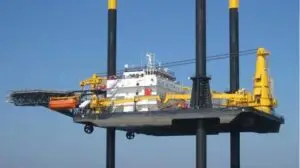– MARINE OPERATIONS OF SELF ELEVATING PLATFORMS
Purpose
A Liftboat – SPJUB (Self Propelled Jack-Up Barge) is a self-propelled, self-elevating vessel used in support of various offshore mineral exploration and production or offshore construction activities and are like the trucks of the offshore fleet.
They carry any kind of equipment necessary to do whatever the job requires. Liftboat jobs include wireline, crane operations, pipe-laying, diver support platforms, work over and offshore coiled tubing operations, temporary housing for construction and service crews, wind turbine installation and servicing, and so on. The list of uses will be limited only by the vision of the operators and demands of the market.
Due to its dual nature of jack up and propulsion for a floater / ship, a need was felt to design a training specially for handling of these type of vessels and so the Liftboat SPJUB handling course, that is to say marine operations of self elevating platforms (MOSEP).
Target Audience Liftboat SPJUB handling marine operations of self elevating platforms Handling (MOSEP)
OOW, Chief officer, Master
Course Content
Ship Handling:
- Stability in sea passage while legs fully up
- Draft in sea passage while leg partly down and passage planning
- Combined use of thruster and soft pin for positioning
- Approach and positioning of Liftboat / SPJUB at the offshore platform
- Station keeping while in a soft pin
- Abandon jacking operation due to jacking equipment failure
- Different designs of Legs
- Rack phase difference (RPD)
- Seabed Characteristics
- 3 leg Vs 4 leg rig stability
- Types of jacking systems
- Spud cans designs on the legs
- Preloading Process and its importance
- Dynamic Positioning if fitted
Operations:
Looking at the liftboat, there are certain key elements to focus on:
Legs and Pads
The vast majority of liftboats are three-legged. The four-legged liftboat will cost more than the cost of simply adding the cost of another leg, i.e., the jacking system to support two legs loaded diagonally is greater and the hull structure is different/heavier. But operationally, the setup time savings of a four-legged equates to money, so, one has to weigh the costs and benefits of three vs. four legs.
Jacking System
The jacking system for a liftboat is very different than the jacking system for a jack-up drilling rig. The two major differences center around speed and cycles.
Working Water Depth
An area with moderate environmental conditions vs. harsh environmental conditions will be a significantly different liftboat design in all aspects, i.e., legs, jacking system and hull.
Deck Area
The deck area is the unobstructed, open area. The liftboat crane is used to move equipment and materials around and on to and off the platform/offshore location. There is a relationship among these variables – open deck area, net deck load and crane capacity. Further, you need a crane capacity that is commensurate with the expected deck loads and area.
Deck Load
The net deck load for a liftboat is what you have on your deck in transit and can then jack up with on the deck. Consumables (such as water, fuel, hydraulic fluid, etc.) are in addition to the net deck load.
There is a definite relationship among deck area, deck load and crane capacity. Liftboats are designed as multi-purpose vessels.
Crane capacity
Types of liftboat cranes, there are lattice boom, box boom, telescopic boom, pedestal mounted, and leg encircling cranes. The main things to consider in crane selection is reach, load capacities and affect on deck area.
Accommodations
The accommodations are another feature of liftboats. The personnel accommodations are generally divided into two areas – navigation crew and customer/operational personnel.
The type of job that the liftboat is performing will dictate the accommodation requirement, i.e., an offshore construction job would generally require more personnel than a well intervention job. The construction job may even require additional modular living quarters on the deck.
Propulsion for liftboat SPJUB Handling
A standard and key feature of a liftboat is that it is self-propelled. This alleviates the need for tugs to move the liftboat or to set up on location. The liftboat can wait for a weather window and move. The larger liftboats have integrated propulsion and bow thrusters.
Liftboat SPJUB handling marine operations of self elevating platforms Handling (MOSEP)
| Course | Fee INR | Duration | Course Timing | Date Commence | Remarks |
|---|---|---|---|---|---|
| Liftboat | 50,000 | 2 days | 10:00 | On Demand |

